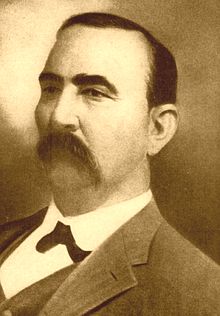William Charles Rogers
| William C. Rogers | |
|---|---|
 William Charles Rogers | |
| Born |
December 13, 1847 Cherokee Nation, Indian Territory (now Tulsa County, Oklahoma) |
| Died |
November 8, 1917 Skiatook, Tulsa County, Oklahoma |
| Occupation | Farmer, merchant, politician |
| Known for | Principal Chief of Cherokee Nation (1903-1917) |
William Charles Rogers (1847-1917) was born in the Cherokee Nation near present-day Skiatook, Oklahoma, USA, on December 13, 1847. A Confederate veteran and successful farmer, he entered tribal politics in 1881.[1]
After serving as a representative and a senator in the Cherokee Council, he was elected Principal Chief of the Cherokee Nation in 1903, defeating E. L. Cookson. He served during the final liquidation of the independent Cherokee government by the United States of America and the establishment of the state of Oklahoma in 1906-7. He remained as principal chief, but with greatly diminished powers, performing largely ceremonial functions for the tribe until his death.
Early life
William Charles Rogers was the son of Charles Coody Rogers and Elizabeth McCorkle. After being educated in tribal schools, he decided to become a farmer like his father. He acquired a tract of land about 2 miles (3.2 km) north of present-day Skiatook, Oklahoma, and began his own farm. In 1877, he constructed a general store on his own land on Bird Creek and established the original town of Skiatook.[1]
Rogers enlisted in the Confederate Army on July 12, 1861, and served as a private for the duration of the conflict in Company E in the First Regiment of Cherokee Volunteers.[1][lower-alpha 1] After the war, he returned to his farm.
Political career
Rogers began his career in tribal politics when he ran for election as a representative of the Cooweescoowee District of the Cherokee Nation in 1881. His bid succeeded and he won reelection in 1883.In 1889, he ran for the tribal senate from the same district, and was reelected in 1889. In 1903, the so-called "Downing Party"[lower-alpha 2] chose him as thir candidate as principal chief to replace Chief Thomas M. Buffington. He was opposed by E. L. Cookson, the candidate of the National Party.[lower-alpha 3] He was elected as the last principal chief elected under the Cherokee Nation.[1][lower-alpha 4]
At the final session of the Cherokee Council on November 9, 1904, he delivered the following message:
| “ | But a crisis in our affairs is at hand. The Government which our forefathers cherished and loved and labored so hard to perfect, has been sentenced to die. The scepter must soon pass to other hands. Still, we must force back the resentment we feel and accept the conditions as they are. The decrees of fate are inexorable. Representative bodies are usually brought together to organize or maintain a government; seldom indeed is the spectacle afforded of such a body of men calmly assembled together to prepare for its own dissolution and yet your coming together is largely for that purpose. The importance of this melancholy fact must not be underestimated or approached in a spirit of indifference. The best service of which you are capable is the demand of the hour and painstaking effort should characterize your every act so that the result may redound to the everlasting credit and benefit of our people.[1] | ” |
Chief Rogers declined to call an election for members of the National Council in 1905. The decisions affecting the termination of the Cherokee Nation government had been made, and Rogers felt there was insufficient work remaining that would justify the cost of an election. Nevertheless, an election was held without his approval. The newly elected members remove Rogers as chief, replacing him with Frank J. Boudinot. Meanwhile, the U.S. Congress had made the Secretary of the Interior responsible for concluding the work of the Dawes Commission. The Secretary designated Rogers as the rightful chief to sign documents for the tribe. He remained in this semi-official position until 1917.[2]
Rogers married Nannie Haynie on February 15, 1892 in Kansas City.[1] His burial place is in Hillside Mission Cemetery, Tulsa County, Oklahoma.[3]
After his four-year term of office was complete, he retained the status of chief, for purposes of dealing with matters of the handover of power to the United States.
Rogers was a Freemason and was buried in Hillside Mission Cemetery, about 3.5 miles (5.6 km) north of Skiatook, Oklahoma.[1][3]
| Preceded by Thomas Buffington |
Principal Chief of the Cherokee Nation 1903–1907 (extended to his death in 1917) |
Succeeded by J. B. Milam |
Notes
- ↑ The regimental colonel was his fellow tribesman, Stand Watie.[1]
- ↑ The Downing Party was named for a post Civil War Principal Chief, Lewis Downing.
- ↑ The National Party was founded by long-time Principal Chief John Ross.
- ↑ In 1902, Congress had selected July 4, 1906 as the date on which Tribal Governments would expire, being replaced by the U. S. Government.[1]
Sources
Chronicles of Oklahoma, Volume 17, No. 2; June, 1939; by John Bartlett Meserve.
References
- 1 2 3 4 5 6 7 8 9 "Chief Thomas Mitchell Buffington and Chief William Charles Rogers," Chronicles of Oklahoma. Volume 17, Number 2. June 1939. Accessed August 15, 2015.
- ↑ Caywood, Elzie Ronald."The Administration of Chief William C. Rogers, Principal Chief of the Cherokee Nation (1903 - 1907). Chronicles of Oklahoma. Accessed November 22, 2015.
- 1 2 "Chief William Charles Rogers." Find-a-grave. Accessed November 22, 2015.